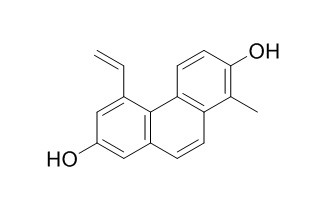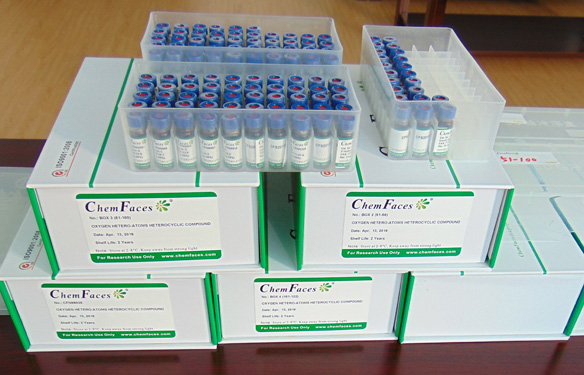Dehydroeffusol
Dehydroeffusol possesses anti-cancer, anxiolytic and sedative properties, it may antagonize the spasmogenic activity of various agents, and therefore, could be a promising agent in the treatment of spasms. Dehydroeffusol displays enhanced antimicrobial activities in light, its antimicrobial activities (minimum inhibitory concentrations) against methicillin-resistant and -sensitive Staphylococcus aureus and Candida albicans are increased 16 fold by irradiation with ultraviolet A (UVA).
Inquire / Order:
manager@chemfaces.com
Technical Inquiries:
service@chemfaces.com
Tel:
+86-27-84237783
Fax:
+86-27-84254680
Address:
1 Building, No. 83, CheCheng Rd., Wuhan Economic and Technological Development Zone, Wuhan, Hubei 430056, PRC
Providing storage is as stated on the product vial and the vial is kept tightly sealed, the product can be stored for up to
24 months(2-8C).
Wherever possible, you should prepare and use solutions on the same day. However, if you need to make up stock solutions in advance, we recommend that you store the solution as aliquots in tightly sealed vials at -20C. Generally, these will be useable for up to two weeks. Before use, and prior to opening the vial we recommend that you allow your product to equilibrate to room temperature for at least 1 hour.
Need more advice on solubility, usage and handling? Please email to: service@chemfaces.com
The packaging of the product may have turned upside down during transportation, resulting in the natural compounds adhering to the neck or cap of the vial. take the vial out of its packaging and gently shake to let the compounds fall to the bottom of the vial. for liquid products, centrifuge at 200-500 RPM to gather the liquid at the bottom of the vial. try to avoid loss or contamination during handling.
Konkuk University2023, 29:4634721
Food Funct.2023, 14(9):4354-4367.
Front Pharmacol.2022, 13:972825.
J Pharm Biomed Anal.2024, 247:116257.
Int J Mol Sci.2019, 20(23):E6071
Turk J Med Sci.2023 53: 1312-1320.
Appl. Sci. 2021, 11(17),7829
Rep.Grant.Res.,Asahi Glass Foun.2023, No.119.
Revista Brasileira de Farmacognosia2024, 34:1156-1165.
Cells.2023, 12(3):395.
Related and Featured Products
Biochem Pharmacol. 2016 Mar 15;104:8-18.
Dehydroeffusol inhibits gastric cancer cell growth and tumorigenicity by selectively inducing tumor-suppressive endoplasmic reticulum stress and a moderate apoptosis.[Pubmed:
26774454 ]
Gastric cancer is ranked as the third leading cause of cancer-related death in the world. Although extensive efforts have been made in recent decades to treat gastric cancer with various anticancer drugs, effective anti-gastric cancer therapeutics to cure the disease are still lacking in the clinics. Therefore, potent novel anti-gastric cancer drugs are greatly needed.
METHODS AND RESULTS:
In this study, we explored a novel anti-gastric cancer agent from a medicinal herb named Juncus effusus and found that the active component Dehydroeffusol (DHE), a small molecular phenanthrene, effectively inhibited gastric cancer cell proliferation and tumorigenesis by inducing tumor suppressive endoplasmic reticulum (ER) stress and by triggering moderate apoptosis. Mechanistic studies revealed that DHE selectively activated the intracellular tumor suppressive stress response by promoting the overexpression of the key ER stress marker DNA damage-inducible transcript 3 (DDIT3), through upregulation of activating transcription factor 4 (ATF4). Concurrently, DHE suppressed the expression of the cell survival and ER stress marker glucose regulated protein of molecular mass 78 (GRP78) via downregulation of the transcription factor ATF6. In addition, DHE markedly activated the stress response signaling pathway MEKK4-MKK3/6-p38-DDIT3, but significantly inhibited ERK signaling.
CONCLUSIONS:
Our data suggest that DHE inhibits gastric cancer cell growth and tumorigenicity through selectively inducing a robust tumor suppressive ER stress response and a moderate apoptosis response. Therefore, DHE may provide a novel drug candidate for further development of potential anti-gastric cancer therapeutics.
Toxicol Appl Pharmacol. 2015 Sep 1;287(2):98-110.
Dehydroeffusol effectively inhibits human gastric cancer cell-mediated vasculogenic mimicry with low toxicity.[Pubmed:
25982451]
Accumulated data has shown that various vasculogenic tumor cells, including gastric cancer cells, are able to directly form tumor blood vessels via vasculogenic mimicry, supplying oxygen and nutrients to tumors, and facilitating progression and metastasis of malignant tumors. Therefore, tumor vasculogenic mimicry is a rational target for developing novel anticancer therapeutics. However, effective antitumor vasculogenic mimicry-targeting drugs are not clinically available.
METHODS AND RESULTS:
In this study, we purified 2,7-dihydroxyl-1-methyl-5-vinyl-phenanthrene, termed Dehydroeffusol, from the traditional Chinese medicinal herb Juncus effusus L., and found that Dehydroeffusol effectively inhibited gastric cancer cell-mediated vasculogenic mimicry in vitro and in vivo with very low toxicity. Dehydroeffusol significantly suppressed gastric cancer cell adhesion, migration, and invasion. Molecular mechanistic studies revealed that Dehydroeffusol markedly inhibited the expression of a vasculogenic mimicry master gene VE-cadherin and reduced adherent protein exposure on the cell surface by inhibiting gene promoter activity. In addition, Dehydroeffusol significantly decreased the expression of a key vasculogenic gene matrix metalloproteinase 2 (MMP2) in gastric cancer cells, and diminished MMP2 protease activity.
CONCLUSIONS:
Together, our results showed that Dehydroeffusol effectively inhibited gastric cancer cell-mediated vasculogenic mimicry with very low toxicity, suggesting that Dehydroeffusol is a potential drug candidate for anti-gastric cancer neovascularization and anti-gastric cancer therapy.
Planta Med. 2014 Aug;80(12):978-83.
Effects of dehydroeffusol on spasmogen-induced contractile responses of rat intestinal smooth muscles.[Pubmed:
25089735]
Dehydroeffusol is a naturally occurring phenanthrene isolated from Juncus effusus.
METHODS AND RESULTS:
In the context of screening new drugs against gastrointestinal spasms, we investigated its effects on isolated rat jejunum in vitro. Dehydroeffusol (30-90 µM) slightly and transiently enhanced contractions in a concentration-dependent manner but significantly inhibited the contractions induced by KCl (100 mM), (±)-Bay-K8644 (5 µM), pilocarpine (90 µM), and histamine (100 µM).
CONCLUSIONS:
These results show that Dehydroeffusol may antagonize the spasmogenic activity of various agents, and therefore, could be a promising agent in the treatment of spasms. Its potential spasmolytic mechanism is also discussed.
Planta Med. 2011 Mar;77(5):416-20.
Anxiolytic and sedative effects of dehydroeffusol from Juncus effusus in mice.[Pubmed:
21104609 ]
Dehydroeffusol, a phenanthrene isolated from Juncus effusus L., possesses characteristic anxiolytic and sedative properties, as determined by an array of behavioral tests in mice.
METHODS AND RESULTS:
In the elevated plus-maze test, Dehydroeffusol significantly increased the number of entries into the open arms and the time the mice spent in these arms in a dose-dependent manner, with a minimum effective dose of 2.5 mg/kg. Dehydroeffusol also significantly increased the head-dips of mice in the hole-board test in a dose-dependent manner, with a minimum effective dose of 5 mg/kg. Dehydroeffusol reduced mouse locomotion in the open-field test with a minimum effective dose of 5 mg/kg. In the rota-rod test, 1-5 mg/kg Dehydroeffusol did not decrease the fall-down time of mice.
CONCLUSIONS:
The above results confirm that Dehydroeffusol possesses anxiolytic and sedative properties and does not affect the general movement coordination of mice. This suggests that Dehydroeffusol is a novel anxiolytic chemical derived from herbal medicines.
Photochem Photobiol. 2002 Jul;76(1):51-6.
Antimicrobial DNA-binding photosensitizers from the common rush, Juncus effusus.[Pubmed:
12126307]
Our continuing survey of phototoxins from higher plants has led to the isolation and identification from the common rush, Juncus effusus L., of the phenanthrene, Dehydroeffusol (1), and the dihydrophenanthrene, juncusol (2), compounds that display enhanced antimicrobial activities in light.
METHODS AND RESULTS:
The antimicrobial activities (minimum inhibitory concentrations) for these compounds against methicillin-resistant and -sensitive Staphylococcus aureus and Candida albicans were increased 16- and two-fold, respectively, by irradiation with ultraviolet A (UVA). Photosensitized DNA-binding activities (as possible covalent bond formation) of these compounds were determined by using restriction enzymes and a specially prepared 1.5 kb DNA fragment. Under UVA irradiation, Dehydroeffusol strongly inhibited all the restriction enzymes (KpnI, XbaI, PmeI, DraI, PacI and BciVI) that have at least one 5'-TpA sequence in their recognition sites. Weak inhibitions were found for the restriction enzymes EcoRI, SacI, BamHI, SalI, PstI and HindIII, which do not possess a 5'-TpA sequence at their restriction sites and the restriction site sequences of which consist of all bases, A, T, G and C. Trace or no inhibition was found for AscI and SmaI, the restriction site sequences of which are composed of only C and G. The results indicate the necessity of thymine (adenine) for the photosensitized DNA-binding activity of Dehydroeffusol. A strong inhibition against SphI, which does not have a 5'-TpA sequence in the restriction sequence, indicates that there are possibly other binding sequence(s) for Dehydroeffusol. With juncusol and UVA, strong inhibitions for KpnI and BciVI and trace inhibitions for PacI, XbaI, PmeI and DraI were found.
CONCLUSIONS:
This result also showed a preference of juncusol for 5'-TpA, but the preference could be more selective than that of Dehydroeffusol depending on the surrounding sequences of 5'-TpA in the respective restriction sites. A strong inhibition of SphI by juncusol with UVA also indicated the existence of an unknown binding sequence for this compound. Generally, the DNA-binding activity of this compound was weaker than that of Dehydroeffusol.



